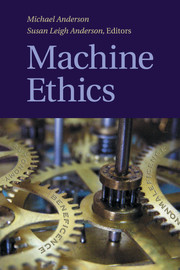Book contents
- Frontmatter
- Contents
- General Introduction
- PART I THE NATURE OF MACHINE ETHICS
- PART II THE IMPORTANCE OF MACHINE ETHICS
- PART III ISSUES CONCERNING MACHINE ETHICS
- PART IV APPROACHES TO MACHINE ETHICS
- PART V VISIONS FOR MACHINE ETHICS
- Introduction
- 28 What Can AI Do for Ethics?
- 29 Ethics for Self-Improving Machines
- 30 How Machines Might Help Us Achieve Breakthroughs in Ethical Theory and Inspire Us to Behave Better
29 - Ethics for Self-Improving Machines
from PART V - VISIONS FOR MACHINE ETHICS
Published online by Cambridge University Press: 01 June 2011
- Frontmatter
- Contents
- General Introduction
- PART I THE NATURE OF MACHINE ETHICS
- PART II THE IMPORTANCE OF MACHINE ETHICS
- PART III ISSUES CONCERNING MACHINE ETHICS
- PART IV APPROACHES TO MACHINE ETHICS
- PART V VISIONS FOR MACHINE ETHICS
- Introduction
- 28 What Can AI Do for Ethics?
- 29 Ethics for Self-Improving Machines
- 30 How Machines Might Help Us Achieve Breakthroughs in Ethical Theory and Inspire Us to Behave Better
Summary
The Rational Architecture
As a basis for analysis, let us use a simplistic model of the workings of an AI mind. The model simply divides the thinking of the AI into two parts:
A world model (WM) contains the sum of its objective knowledge about the world and can be used to predict the effects of actions, plan actions to achieve given goals, and the like.
A utility function (UF) that establishes a preference between world states with which to rank goals.
In practice, the workings of any computationally realistic AI faced with real-world decisions will be intertwined, heuristic, and partial, as indeed are the workings of a human mind. At present, only programs dealing with limited, structured domains such as chess playing are actually formalized to the extent of separating the WM and the UF. However, it can be shown as one of the fundamental theorems of economics that any agent whose preference structure is not equivalent to a single real-valued total function of world states can be offered a series of voluntary transactions that will make it arbitrarily worse off – even by its own reckoning! To put it another way, any agent that doesn't act as if it had a coherent UF would be an incompetent decision maker. So as we increasingly use AIs for decisions that matter, we should try to build them to match the model as closely as possible as an ideal.
Information
- Type
- Chapter
- Information
- Machine Ethics , pp. 512 - 523Publisher: Cambridge University PressPrint publication year: 2011
Accessibility standard: Unknown
Why this information is here
This section outlines the accessibility features of this content - including support for screen readers, full keyboard navigation and high-contrast display options. This may not be relevant for you.Accessibility Information
- 8
- Cited by
